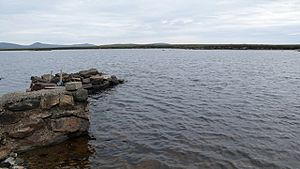Loch Sgadabhagh facts for kids
Loch Sgadabhagh, also known as Loch Scadavay, is a large freshwater loch (which is the Scottish word for lake) located on the island of North Uist in Scotland. It's famous for its incredibly twisty and complex shape, almost like a maze of water, land, and islands! While it's the biggest loch on North Uist by how much surface area it covers, another loch called Loch Obisary actually holds about twice as much water. The name "Sgadabhagh" might come from an old Viking language, meaning "lake of tax bay," but no one is quite sure why it's called that.
Quick facts for kids Loch Sgadabhagh |
|
|---|---|

Loch Sgadabhagh, southern portion
|
|
| Location | North Uist, Eilean Siar |
| Coordinates | 57°35′44″N 7°15′13″W / 57.59556°N 7.25361°W |
| Type | Freshwater loch |
| Primary outflows | Garbh-Abhuinn |
| Basin countries | Scotland |
| Max. length | 7.25 km (4.50 mi) |
| Max. width | 3 km (1.9 mi) |
| Surface area | 453 ha (1,120 acres) |
| Average depth | 2.75 m (9 ft 0 in) |
| Max. depth | 15.1 m (50 ft) |
| Water volume | 11,836,442 m3 (418,000,000 cu ft) |
| Shore length1 | 80.5 km (50.0 mi) |
| Surface elevation | 5 m (16 ft) |
| Islands | Eilean Dubh Mòr |
| Sections/sub-basins | Numerous |
| Settlements | Lochmaddy |
| 1 Shore length is not a well-defined measure. | |
Contents
Exploring Loch Sgadabhagh's Unique Shape
Loch Sgadabhagh is truly one-of-a-kind! Experts have said there's probably no other loch in Britain quite like it. It's an amazing maze of narrow channels, hidden bays, long pieces of land sticking out (called promontories), and many islands.
The main road, the A867, actually crosses the loch. The northern and southern parts of the loch are connected by a very small channel under this road. Usually, the water levels are the same, but during heavy rain or floods, the southern part can temporarily rise a few feet higher than the northern part!
Size and Depth
This loch stretches for over 7.25 kilometres (4.50 mi) (about 4.5 miles) and is more than 3 kilometres (1.9 mi) (nearly 2 miles) wide in some places. Its shoreline is incredibly long, measuring about 80.5 kilometres (50.0 mi) (50 miles) in total!
Even with its huge size, the average depth of the loch is only about 2.75 metres (9.0 ft) (9 feet). Some of the narrow channels leading into its long, arm-like sections are even shallower, sometimes less than 1 metre (3.3 ft) (3 feet) deep. The total area of the loch is 453 hectares (1,120 acres) (about 1,120 acres). The deepest spots are 11.2 metres (37 ft) (37 feet) in the northern part and 15.1 metres (50 ft) (49.5 feet) in the southern part.
Water Flow
Two very short streams flow into Loch Sgadabhagh, bringing water from nearby Loch nan Eun and Loch a' Bhuird. The Garbh-Abhuinn (which means "rough river" in Scottish Gaelic) is the biggest stream in this area. It flows eastward from the northern part of Loch Sgadabhagh into Loch Garbh-Abhuinn. From there, the water continues through Loch Skealtar and Loch nan Geireann before finally reaching the sea near Loch Maddy.
Shoreline Features
The edges of the loch are made up of different materials. In some places, you'll find soft peat, while in others, there are stones, gravel, large boulders, or solid rock. The easternmost arm of the southern loch is quite dramatic, with steep rocky cliffs that rise up to 10 metres (33 ft) (33 feet) high on both sides!
Islands of Loch Sgadabhagh
Loch Sgadabhagh is dotted with many islands. The biggest one is called Eilean Dubh Mòr. Some of these islands were once home to ancient forts called dùns or artificial islands known as crannogs. In some cases, these islands would have been connected to the mainland by narrow pathways built across the water, called causeways.
An Ancient Island Fort
One interesting island, located between two promontories called Rubh' a' Chlachain and Aird Smeilis, is described as a walled islet. It's connected to the shore by a special S-shaped causeway. Imagine walking along this winding path to reach a fort!
According to a description from 1911, near where the causeway meets the island, there was a gateway. This gateway led to a guard-chamber built right against the inside wall of the fort. The walls of this chamber were quite thick, between 2 feet (0.61 m) and 3 feet (0.91 m) (0.6 to 0.9 meters), enclosing a rectangular area about 6 feet (1.8 m) by 8 feet (2.4 m) (1.8 by 2.4 meters).
There were also three other smaller, round or oval buildings on the island, which might have been temporary shelters for shepherds, known as sheilings. But near the center of the island, there was a more important building with 2 feet (0.61 m) thick walls, enclosing a circular area about 12 feet (3.7 m) (3.7 meters) across. On the west side of the island, there's even a semicircle of stones that forms a small, sheltered harbor.
Because of all these islands and the narrow channels, there isn't really any wide-open water on the loch that's broader than about 0.8 kilometres (0.5 mi) (half a mile). Also, in the shallower parts, small boulders often stick out of the water, which can make it tricky to navigate a boat across the loch.


